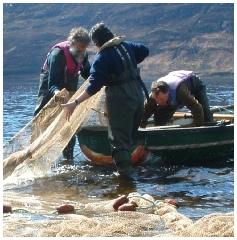Post smolt netting and tagging of sea trout in estuaries
Sweep netting is carried out on the estuaries and all trout of a certain size are tagged. At present very little is known about sea trout habitat use during the marine phase of its lifecycle, and recaptured fish give information on growth rates and marine migrations. Numbers of sea lice on each fish are also recorded allowing comparisons with neighbouring fish farms as part of the assessment of the affects of these farms on wild salmonids.
How and why?
Post-smolt netting takes place between March and October during low tide. The Laxford and Polla estuaries are sampled monthly where possible (depending on river height and number of volunteers). A 50 metre sweep net is hand pulled across the estuary in a large circle to give one sweep of the area. All fish caught are transferred to baskets and anaesthetised for ease of processing. Whilst sea trout is the target species, other fish including sticklebacks, flounders, pollack and saithe amongst others are often caught as bycatch. All fish are released back into the estuary upon recovery.
Netting started in 1997 as part of a project compiling information relating to sea trout population dynamics in the local area. The monitoring of post-smolts was originally designed to give an indication of the migrations and growth rates of sea trout during their marine phase. The tagging of individual fish, along with measurements taken at capture, gave baseline data from which to assess growth and movements following recapture by nets or rod and line. Additional information about sea lice burdens and gill disease on trout has also provided an analysis of the relationship between fish farms and sea trout. Sea lice counts are now one of the main parts of the project with the tagging of fish providing more information.
Click here to see a video of sweep netting in action! With aerial footage and fish release.
|
|
|
|
|
|
|
|
Processing Fish:
Each fish yields a lot of information:
Sea lice counts - two types of sea louse are found on salmonids, Caligus elongatus (sea louse) and more commonly Lepeophtherius salmonis (salmon louse). Lice on each fish are counted and the species and life stages (chalimus, mobile, adult, gravid female) noted. The information is shared with the neighbouring fish farm and used for management purposes.
|
|
|
|
Length and weight - these can be used to determine the condition index and give an idea of the health of the fish. These measurements will be also be used as a baseline from which to calculate growth rates should the fish be recaptured in the future.
Scale samples - scales taken from just behind the dorsal fin above the lateral line are used to age the fish by counting the dark bands of winter growth. We can also find out if the fish have spawned by looking at the scales.
Gill disease - a visual assessment of the gills is undertaken for AGD and PGD, which are scored dependent on severity. The information is shared with the local fish farm.
Tags - each fish is tagged with a Visible Impact (VI) tag behind the eye. Recaptures give information on marine migrations and growth rates.
Some interesting facts:
|
|
The oldest fish - J77, recaptured in the Polla estuary on 27th May 2013, eight years after being tagged as a three year old smolt in 2005. The second oldest fish, J01 and D13 were recaptured 5 years after tagging.
The most travelled - G33 was captured in the River Hope 6 weeks after being tagged in the Laxford estuary.
The most recaptured in one year - I20 was taken 3 times in the Polla in 2010.
Reports detailing netting results are available under publications.










